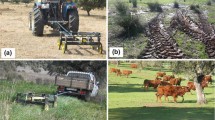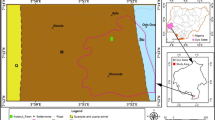Abstract
Every growing season, paddy fields are kept both flooded and drained for a significant period of time. As a consequence, these soils develop distinct physico-chemical characteristics. For practical reasons, these soils are mostly sampled under dry conditions, but the question arises how representative the results are for the wet growing conditions. Therefore, the apparent electrical conductivity (ECa) of a 1.4 ha alluvial paddy field located in the Brahmaputra floodplain of Bangladesh was measured in both dry and wet conditions by a sensing system using the electromagnetic induction sensor EM38, which does not require physical contact with the soil, and compared both surveys. Due to the smooth water surface under wet conditions which ensured increased stability of the sensing platform, the results of the survey showed considerably reduced micro-scale variability of ECa. Furthermore, the wet survey results more reliably furnished soil-related information mainly due to the absence of soil moisture dynamics. The differences between ECa under wet and dry conditions were attributed to differences in soil texture, mainly the sand content variation having considerable effect on soil moisture differences when flooded following drainage. Accordingly, the largest differences between ECa under wet and dry conditions were found in those parts of the field with a large sand content. Hence, the conclusion was that an ECa survey on flooded fields has an added value to precision soil management.





Similar content being viewed by others
References
Brammer, H. (1981). Reconnaissance soil survey of Dhaka district. Revised edition (pp. 6–19). Dhaka: Soil Resources Development Institute.
Brammer, H. (1996). The geography of the soils of Bangladesh (p. 25). Dhaka: The University Press Limited.
Brevik, E. C., Fenton, T. E., & Lazari, A. (2006). Soil electrical conductivity as a function of soil water content and implications for soil mapping. Precision Agriculture, 7, 393–404.
Goovaerts, P. (1997). Geostatistics for natural resources evaluation. New York, NY: Oxford University Press.
IRRI. (1987). Physical measurements in flooded rice soils: The Japanese methodologies. Los Baños, Manila: International Rice Research Institute.
Islam, M. M., & Van Meirvenne, M. (2011). FloSSy: A floating sensing system to evaluate soil variability of flooded paddy fields. In J. V. Stafford (Ed.), Proceedings of the 8th European conference on precision agriculture (pp. 60–66). Prague, Czech Republic: University of Life Sciences.
McNeill, J. D. (1980). Electromagnetic terrain conductivity measurement at low induction numbers. Technical Note TN-6. Missisauga, ON: Geonics Limited.
Rhoades, J. D., Chanduvi, F., & Lesch, S. M. (1999). Soil salinity assessment: Methods and interpretation of electrical conductivity measurements. FAO Rep. 57. Rome: FAO.
Saey, T., Simpson, D., Vermeersch, H., Cockx, L., & Van Meirvenne, M. (2008). Comparing the EM38DD and DUALEM-21S sensors for depth-to-clay mapping. Soil Science Society of America Journal, 73, 7–12.
Saey, T., Van Meirvenne, M., Vermeersch, H., Ameloot, N., & Cockx, L. (2009). A pedotransfer function to evaluate the soil profile textural heterogeneity using proximally sensed apparent electrical conductivity. Geoderma, 150(3–4), 389–395.
Sheets, K. R., & Hendrickx, J. M. H. (1995). Non-invasive soil water content measurement using electromagnetic induction. Water Resource Research, 31, 2401–2409.
Simpson, D., Lehouck, A., Verdonck, L., Vermeersch, H., Van Meirvenne, M., Bourgeois, J., et al. (2009). Comparison between electromagnetic induction and fluxgate gradiometer measurements on the buried remains of a 17th century castle. Journal of Applied Geophysics, 68(2), 294–300.
Sudduth, K. A., Hummel, J. W., & Birrell, S. J. (1997). Sensors for site-specific management. In F. J. Pierce & E. J. Sadler (Eds.), The state of site-specific management for agriculture (pp. 183–210). Madison, WI: ASA-CSSA-SSSA.
Triantafilis, J., Laslett, G. M., & McBratney, A. B. (2000). Calibrating an electromagnetic induction instrument to measure salinity in soil under irrigated cotton. Soil Science Society of America Journal, 64, 1008–1017.
Author information
Authors and Affiliations
Corresponding author
Rights and permissions
About this article
Cite this article
Islam, M.M., Meerschman, E., Saey, T. et al. Comparing apparent electrical conductivity measurements on a paddy field under flooded and drained conditions. Precision Agric 13, 384–392 (2012). https://doi.org/10.1007/s11119-011-9253-2
Published:
Issue Date:
DOI: https://doi.org/10.1007/s11119-011-9253-2




